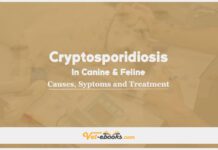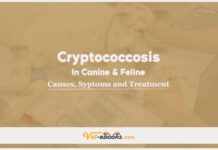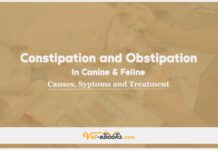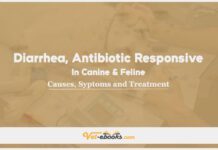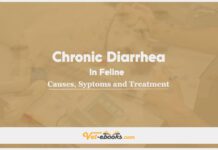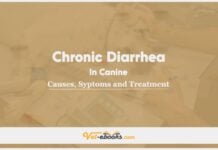Canine parvovirus In Canine: Causes, Symptoms and Treatment
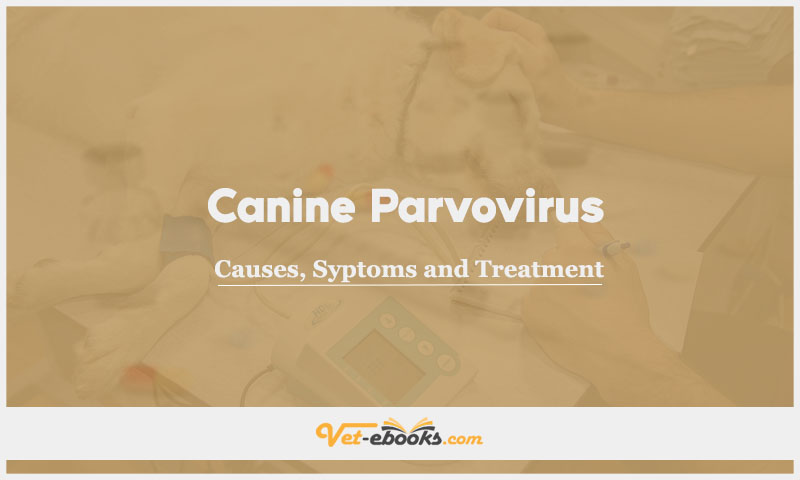
Overview
A viral infection in young dogs (aged 6-16 weeks) and sometimes cats that leads to systemic illness primarily affecting the gastrointestinal and immune systems.
It is characterized by symptoms such as loss of appetite, vomiting, bloody and watery diarrhea, and sepsis due to a severe neutropenia.
Causes of Canine parvovirus
Causes
- CPV-2 canine parvovirus.
- Canine parvovirus (CPV)-2 has undergone antigenic alterations, resulting in the identification of CPV2a, CPV2b, and CPV2c strains.
- The original virus has become almost non-existent in domestic dogs.
- CPV2c variants exhibit greater virulence and higher mortality rates.
- CPV-2 is closely linked to the feline panleukopenia virus (FPV).
Risk factors
- Dogs without vaccination.
- Dogs younger than four months.
- Other disease-causing agents like parasites, viruses, and specific bacteria (such as Campylobacter spp. and Clostridium spp.) can worsen the disease.
- Severe, frequently fatal parvoviral infections have been observed in puppies exposed to both CPV-2 and canine coronavirus simultaneously.
- Overcrowded conditions and inadequate hygiene.
Pathogenesis of Canine parvovirus
- Dogs can be affected by two types of canine parvovirus: CPV-1, known as the minute virus of canines, and CPV-2, which causes gastrointestinal (GI) tract disease.
- CPV-1 has uncertain pathogenicity and has been linked to “fading puppy syndrome,” causing symptoms like lethargy, loose stools, respiratory distress, and sudden death in 1- to 3-day-old puppies.
- CPV-2 first emerged in 1977 and is closely related to feline panleukopenia virus and mink enteritis virus.
- CPV-2a and CPV-2b appeared in 1980 and 1984, respectively, exhibiting different antigenic structures, increased pathogenicity, and a shorter incubation period compared to CPV-2.
- CPV-2c was reported in Italy in 2000 and spread globally, including the United States, by 2007.
- CPV-2a, -2b, and -2c can also replicate in cats.
- Modified live (MLV) vaccines developed against the original CPV-2 and -2b strains can provide protection against CPV-2a, 2b, and 2c.
- Infection typically starts fecal/oral, followed by viral replication in tonsilar lymphoid tissue initially, and then spreads to other lymphoid tissues like bone marrow, mesenteric nodes, and the thymus.
- Viremia occurs around day 3-5 post-infection, preceding clinical signs, and the virus can be detected in intestinal epithelial cells by day 4 post-infection.
- Fecal shedding of the virus occurs shortly after viremia, with substantial amounts of the virus excreted in the feces of clinically affected dogs, usually lasting no more than day 12 post-infection.
- CPV targets rapidly dividing cells in the intestine, such as crypt cells in the distal duodenum and jejunum, bone marrow, and occasionally myocardial tissue. Regarding the impact on the dog’s health:
Enteritis:
- Commonly observed in puppies aged 6-16 weeks.
- It results from the destruction of dividing crypt cells, leading to the loss of enteric cells moving up the villus and denuded villus formation.
- Most clinical signs are due to damage to crypt cells and lymphoid/bone marrow destruction.
- Severe cases can develop sepsis and endotoxemia from gram-negative enteric bacteria.
Bone Marrow:
- CPV causes necrolysis of both myeloid and erythroid stem cells in the marrow.
- Anemia may occur due to blood loss from the bowel.
- There is a marked reduction in leukocyte counts beginning from day 3 to 5 post-infection.
- Myeloid destruction with significant reductions in white blood cell (WBC) counts occurs with or just after the onset of clinical signs.
- An eosinophil count greater than 0.1 with a left shift is a reliable indicator of a favorable outcome.
- A significant increase in lymphocytes within the first 24 hours after admission is a more meaningful predictor of recovery than the total white blood cell count.
- In survivors, an elevation in monocytes typically occurs before an increase in polymorphonuclear neutrophils (PMNs).
- The presence of eosinophils 48 hours after admission is a positive sign for prognosis.
Myocardial Disease:
- Cardiac myocytes can only support CPV growth in the first 2 weeks of a puppy’s life.
- Infection occurs in utero or within the first weeks of life.
- Puppies with any degree of passive immunity from their dam are immune.
- Myocarditis is not seen until pups are 6-8 weeks old and can lead to acute death.
Symptoms (History & Physical Examination) of Canine parvovirus
History
- Young dogs, typically ranging from 6 to 16 weeks of age.
- Certain dog breeds, including rottweilers, Doberman pinschers, pit bull terriers, German shepherds, English springer spaniels, Alaskan sled dogs, and possibly Labrador retrievers, appear to have a higher predisposition to more severe infections and can potentially be infected as adults.
- Cats can contract CPV-2a and -2b and display clinical symptoms resembling those observed in dogs, although such cases are infrequent.
Physical examination
- The severity of the condition can vary significantly based on factors such as age, immunity, the presence of coexisting pathogens like parasites or enteric bacteria, and the amount of virus exposure.
- In kennels, crowded conditions and inadequate sanitation can diminish the effectiveness of vaccination.
- However, it’s important to note that crowded and unsanitary environments do not necessarily worsen the severity of the disease in individual animals. It’s not uncommon to have some puppies in a litter unaffected while others experience acute illness.
- Common clinical signs include depression, loss of appetite, vomiting (with or without fever), repeated vomiting episodes (sometimes with roundworms in the vomit), profuse mucoid and subsequently bloody diarrhea, leading to rapid and severe weight loss.
- Tachycardia, pale and tacky mucous membranes, and abdominal pain or discomfort may also be observed in affected animals.
- Occasionally, signs of cerebellar hypoplasia may be present, although this is a rare occurrence in dogs and is more commonly associated with feline panleukopenia infection.
Diagnosis of Canine parvovirus
1- From History and Physical Examination
2- Diagnostic Procedures
- Electron microscopy can identify the presence of the virus in fecal samples during the early stages of infection.
- For virus detection, it’s advisable to submit samples during the acute phase of infection, and when shipping specimens, they should be kept refrigerated rather than frozen.
Pathological findings
- Gross changes may involve subserosal congestion and hemorrhage, or even significant bleeding into the small intestinal lumen. In some cases, the intestines may appear empty or contain yellowish or blood-tinged fluid.
- The mesenteric lymph nodes are often enlarged and edematous, with hemorrhages occurring in the cortex.
- Young dogs may exhibit thymic atrophy.
- In dogs with myocarditis and heart failure, the only noticeable gross changes may be pulmonary edema and hydropericardium.
- On a histopathological level, the infection is characterized by intestinal inflammation and necrosis, often accompanied by severe villus atrophy.
CBC, Biochemistry, and Urinalysis
- Lymphopenia, a characteristic finding, often occurs around days 4 to 6 post-infection.
- Dogs with severe illness may develop significant neutropenia as intestinal damage sets in.
- Leukocytosis is commonly observed during the recovery phase.
- Serum chemistry profiles are valuable for evaluating electrolyte imbalances, particularly hypokalemia, as well as the presence of azotemia, panhypoproteinemia, and hypoglycemia.
Other Laboratory Tests:
- The virus can be detected in stool samples at the onset of the disease and for up to 2-4 days afterward. Various commercial point-of-care ELISA assays are available, along with PCR and quantitative PCR methods.
- Serologic tests are not diagnostically reliable because dogs often have elevated titers from vaccination or maternal antibodies.
Imaging:
- Abdominal radiographs typically reveal a generalized small intestinal ileus. Care should be taken to avoid misdiagnosis of intestinal obstruction, although intussusception may create an obstructive pattern.
- Abdominal ultrasound often shows fluid-filled, atonic small and large intestines, thinning of the duodenal and jejunal mucosal layers with or without indistinct wall layers, irregular luminal-mucosal surfaces, extensive hyperechoic mucosal speckling in the duodenum and/or jejunum, and duodenal and/or jejunal corrugations. Intussusceptions can also be identified through ultrasound.
3- Differential Diagnosis
- It’s important to consider all potential causes of diarrhea, which can range from systemic or metabolic conditions to specific intestinal disorders. However, when dealing with puppies, particular attention should be given to these possibilities.
- Other factors that can lead to acute enteritis include dietary indiscretion, ingestion of foreign objects, inflammatory bowel disease (IBD), hemorrhagic gastroenteritis (HGE), intussusception, drug reactions (particularly antibiotics), exposure to toxins like lead, parasitic infections (such as roundworms, cryptosporidiosis, giardiasis, coccidiosis, and whipworms), various infectious agents (such as salmonellosis, Campylobacter spp., bacterial overgrowth in the GI tract, clostridiosis, and coronavirus), systemic organ dysfunction (including issues with the kidneys, liver, or pancreas), metabolic conditions like hypoadrenocorticism, and the possibility of neoplasia (such as GI tract lymphoma or adenocarcinoma) in older dogs.
- To distinguish parvovirus infection from other causes of acute diarrhea, it’s important to note the presence of a significant decrease in neutrophil count, which can be apparent even through a stained direct blood smear without performing a full cell count.
Treatment of Canine parvovirus
General
- Intensive therapy with hospitalization has a significant positive impact on survival rates.
- Infected patients should be isolated from other patients because they excrete a large amount of the virus.
- Puppies that are not vomiting and not severely dehydrated can be treated as outpatients.
- The primary therapy involves intravenous crystalloid fluid administration to address dehydration and ongoing fluid loss due to vomiting and diarrhea.
- To prevent abscess formation, it’s important to avoid subcutaneous fluid administration in neutropenic patients.
- Special attention should be given to catheter maintenance since a substantial proportion (up to 22%) of CPV patients develop bacterial colonization of IV catheters.
- In cases of hypoalbuminemia, colloid therapy may be beneficial, and whole blood or plasma can be used if there is severe blood loss due to diarrhea.
- Early enteral nutrition through a nasogastric feeding tube upon admission has been shown to improve the overall health, recovery time, and survival of dogs with CPV infection. Efforts should be made to manage vomiting and initiate early feeding.
- The supplementation of glutamine can enhance the health of enterocytes.
- When transitioning to regular food, it’s advisable to start with a bland diet (such as Hill’s i/d or Purina EN) and gradually shift to the normal diet.
- Avoid misdiagnosing intestinal obstruction, especially if vomiting is the only clinical sign.
- Intussusceptions can occur and should be considered in the diagnostic process.
Medications:
- If vomiting persists, antiemetics should be administered. Preferred choices include Metoclopramide 0.2–0.4 mg\kg SC for 5 days or 1–2 mg\kg IV for 5 days or the serotonin receptor antagonist ondansetron 0.5–1 mg\kg for 5 days. However, phenothiazines like promethazine and chlorpromazine may exacerbate lethargy and low blood pressure.
- H2 blockers like famotidine 0.5–1 mg\kg for 5 days may help alleviate nausea.
- Broad-spectrum antibiotics are essential to prevent and treat sepsis. This treatment should cover a range of gram-negative organisms. Commonly used antibiotics include ampicillin 10–20 mg\kg SC, IM, IV for 10 days, cefazolin 22mg\kg IM, IV 8 for 10 days, ceftiofur 2.2–4.4 mg\kg SC for 10 days, and sometimes a combination with gentamicin 2–4 mg\kg SC, IM for 5 days, unless the patient is very young or dehydrated. Metronidazole is also an option.
- Anthelmintic therapy using fenbendazole 50 mg\kg PO for 3 days should be considered for concurrent parasitism once vomiting has stopped.
Some Notes:
- Vaccination typically involves administering modified live vaccines (MLV) at 6, 9, and 12 weeks of age. In certain breeds susceptible to CPV, like rottweilers and Dobermans, a third dose may be given at 16-22 weeks.
- All currently available MLV vaccines offer protection against all known CPV subtypes.
- An alternative option is an intranasal modified live CPV-2b vaccine, which also provides effective protection.
- The primary reason for vaccine failure is interference from maternal antibodies.
- Most vaccine manufacturers recommend yearly booster vaccinations, it is likely that dogs only need a booster vaccination every three years.
- Dogs naturally receive immune-boosting exposure to wild-type CPV in their environment throughout their lives, reducing the necessity for regular booster shots.
- Dogs that have recovered from a CPV infection typically develop lifelong immunity, eliminating the need for future vaccinations.
- Avoid fluoroquinolones in puppies due to the risk of cartilage defects.
- The use of gentamicin in dehydrated patients should be avoided. Monitoring for the appearance of casts in urine is necessary to prevent nephrotoxicity.
- Surgical interventions should be avoided when severe neutropenia is present.
- Prolonged antibiotic therapy may lead to the development of oral and intestinal candidiasis.
- Recovery from CPV infection is typically complete within 7-10 days, even in severely affected cases.
- Possible complications of the infection may include intussusception, disseminated intravascular coagulation (DIC), endotoxic shock, or sepsis.
- Dogs that receive prompt initial treatment and survive the initial crisis have a good prognosis, with an approximate 80% survival rate.
- A poor prognosis is expected in purebred patients with low body weight and specific biomarker levels present after 24 hours of intensive therapy. These markers include severe and persistent leuko- and lymphopenia, consistently elevated or rising serum cortisol levels (>8.1 μg/dL), severe hypothyroxinemia (<0.2 μg/dL), hypocholesterolemia (<100 mg/dL), and persistently elevated serum C-reactive protein (>97.3 mg/L).
- Conversely, puppies with good prognosis are of mixed breed, over 6 months old, and exhibit specific biomarker values, including a total leukocyte count >4.5 × 103/μL, lymphocyte count >1 × 103/μL, and mature neutrophil count >3 × 103/μL. Furthermore, a serum cortisol concentration <8.1 μg/dL at 48 hours after admission is associated with a 96% survival rate, while a serum thyroxine concentration >0.2 μg/dL at 24 hours after admission is linked to a 100% survival rate. An HDL-cholesterol concentration >50.2 mg/dL at admission is also associated with 100% survival.
Tip
Do You Want To Increase Your Veterinary Knowledge and Practical Skills?
You Can Now Browse and Download +3000 Books For Veterinary Professionals & Students Online.
Download Veterinary Books

